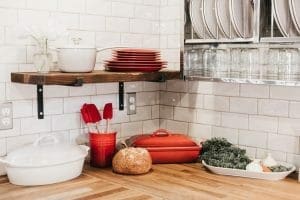I’m going through my apartment step by step to make it more eco-friendly because I want to and, honestly, I need to walk the walk. In particular, I want to have an eco-friendly kitchen. Belgian high school students have been peacefully demonstrating every Thursday to persuade the government to act on climate concerns, and they have received a lot of attention.
I appreciate the youngsters advocating for their right to a cleaner future. So, hypocritical me needs to put forth more effort as well. When something has to be replaced, I take it one step at a time and seek a long-term solution.
I believe that the term “sustainable” has a poor reputation for being associated with “expensive,” which I discovered is not the case. So there will be no more excuses!
Table of Contents
Quick Vocab Tutorial

SUSTAINABLE – also known as GREEN LIVING, Products/goods are created from environmentally friendly materials such as sustainably cultivated crops or recyclable content. They provide environmental, social, and economic advantages while preserving public health and the environment over their entire life cycle, from raw material extraction to final disposal.
ECO-FRIENDLY — does not affect the environment. Translated as “earth-friendly,” this term refers to activities that promote green living and assist in saving resources such as water and electricity. Prevents air, water, and land contamination. Also known as low-impact living.
ZERO-WASTE – is a concept that promotes the repurposing, reuse, and recycling of used items, with no garbage dumped in landfills, incinerators, or the ocean.
BIODEGRADABILITY – the ability to be decomposed by bacteria or other living creatures, therefore avoiding pollution. It’s a normal chemical reaction. Products are meant to decompose in landfills.
COMPOSTABLE – is biodegradable, but only under specific conditions induced at the local recycling center. It must be treated before it may be recycled or degraded.
3 Basic Efforts
Before going deep, let’s learn the practice of three basic efforts the best we can-
1. Stop Single-Use
It’s the most significant habit modification I’ve made. I used ziplock bags as if my life depended on them, and my plastic trash was out of control. I now use reusable containers as well as reusable silicone bags and lids. In addition, I’ve given up on kitchen paper towels and wet wipes in favor of washable washcloths.

2. Ditch the Chemicals
Of course, eco-friendly soaps may be substituted; some are more costly than others, but I wanted to try creating my own. So I began washing my kitchen countertops with the following homemade solution: In a glass spray bottle, combine 1 cup white vinegar, 2 cups water, and a few drops of essential oil or lemon juice.
It works flawlessly. Check the composition of your kitchen counter surfaces to see if vinegar is safe to use. Also, do not wipe your eyes when using vinegar (I learned that the hard way).
3. Just Do It
Begin small and work your way up. The goal is to get started; I began by recycling plastic and was shocked to realize how much plastic I discarded every week. That prompted me to seek replacements and alternatives. I’m not quite where I want to be, but I’m getting there.
15 Budget-Friendly Alternatives to Eco-Friendly Kitchen
So I conducted some research and discovered 15 simple and cost-effective alternatives to common cooking behaviors that I altered without any effort, and you can too.
1. Ditch the Paper Towels and Wipes
It was terrible how many wipes I was using. I now use washable and reusable dish towels.

2. Use Durable Utensils in your Eco-Friendly Kitchen
I still have some plastic and silicone utensils, but I primarily use wood and stainless steel. Investing in high-quality goods is essential for long-term success.
3. Replace Sponges
When I read that a sponge takes 500 to 1000 years to deteriorate, I made a significant modification. Look for sponges that are manufactured from recycled plastic or that are entirely biodegradable.
4. Use Wooden Cutting Boards in your Eco-Friendly Kitchen
I adore lovely wooden boards for serving tapas, but I converted to Epicurean non-slip cutting boards years ago. They began as a skate ramp construction firm before using leftover wood composite for cutting boards. I adore the silicone anti-slip corner.
5. Clean With Natural Cleaning Products
To clean my kitchen counters, I use a homemade recipe. Consider this: you clean with chemicals that, while killing germs, leave compounds on the surface on which you then lay your food.
I combine one part white vinegar, two parts water, a dash of lemon juice, and ten drops of lavender essential oil. It works flawlessly. If you don’t want to make your own, there are lots of non-harmful over-the-counter items available.
6. Use Reusable Straws in your Eco-Friendly Kitchen
It’s a no-brainer. Reusable straws are now widely available.
7. Store Food Plastic Free
It’s something I’ve always done to reuse and recycle jars. I like the look simply because I adore keeping stuff in jars. Full disclosure: I remodeled my pantry cabinet two years ago and purchased plastic containers since glass containers would have been too heavy for my little wardrobe. I don’t use ziplock bags or plastic wrap anymore. Instead, I purchased some reusable silicone bags and lids, which work well.
8. Replace Parchment Paper With Baking Mats
I’ve been doing that for years and, to be honest, I think it results in a more even bake. Food bloggers love to utilize white baking paper as a prop in our pictures; instead of throwing it away each time, I now re-use it.
9. Elevate Your Dinner Table With Cloth Napkins, Ditch the Paper
I enjoy using crazy, humorous phrase paper napkins to serve beverages to visitors. However, I use a cloth napkin daily. When it comes to arranging a beautiful table, cotton napkins are unquestionably the finest option, even from an aesthetic standpoint.
10. Filter and Drink Tap Water

I quickly consumed 1.5 to 2 liters of bottled water daily, which was a lot of plastic. Last year, I tried to drink solely filtered tap water for three months. As a result, after a few weeks, I rarely drank water, which was also unhealthy.
Even after filtering, I don’t enjoy my Brussels tap water (a must for all tea lovers). So I flavored the water with lemon, lime, cucumber, red berries, peaches, watermelon, and other fruits. But now and again, I want a tall glass of water.
I’ve cut my bottled water usage by 3/4, so that’s a HUGE accomplishment. I keep carafes of flavored tap water in my fridge at all times, and I drink a lot of tea (warm and cold).
11. Use Durable Pots and Pans in your Eco-Friendly Kitchen
I converted to Le Creuset pots and pans 15 years ago. The secret is to buy long-lasting items, which regrettably requires a small expenditure. Consider this: you will never need to repurchase a new pot or pan.
12. Choose Energy-Efficient Eco-Friendly Kitchen Appliances – Run Dishwasher When Full
Last year, I replaced my washing machine, which had served me dutifully for 16 years. I chose an energy-efficient machine with a bigger capacity load and am happy with it. I don’t have a dryer, so I hang my clothes to dry. I fill the dishwasher all week and only run it once a week when it’s full.
13. Recycle

For a long time, I used my small flat and kitchen as an excuse. I now recycle plastic and aluminum cans ( the blue recycle bag). I’m also focusing on improving the efficiency with which I recycle paper and cardboard.
I brazenly threw away my empty bottles of bubbly and champagne. I now divide them and transport them to the glass containers at the end of the block.
14. Switch Your Light Bulbs to LEDs
That was simple since I don’t believe there are any other light bulbs available in Belgian retailers. Moreover, they endure forever; I don’t think I’ve changed much in ten years.
15. Grow Your Own Herbs
In the winter, I grow indoors, and in the summer, I grow outside. I produce some vegetables, such as radishes and green beans every year. It’s rewarding to consume something you’ve raised.
Conclusion
Now that you know the kitchen swaps and ideas, you can have more innovative ideas. Remember, reusing is the key to having a sustainable kitchen. Another great practice in common households is using plastic materials to store food; opting for plastic-free food storage will make your kitchen greener.


